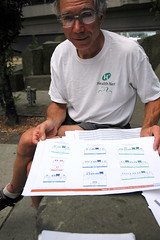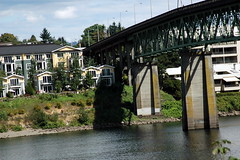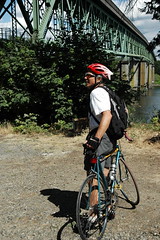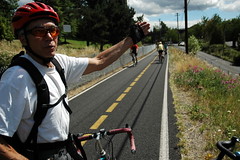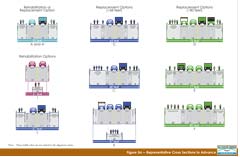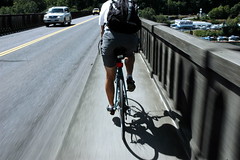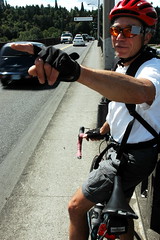
(All photos: Jonathan Maus)
Last week I spent a day with Richard Marantz to get the lowdown on bicycle access issues in the Sellwood Bridge Project.
Richard is an avid bicyclist and member of the project’s Citizens Task Force. He is also acting as a volunteer liaison for the BTA (due to a staffing crunch, they were unable to devote paid staff.)
For those of you who haven’t heard, the 81 year-old Sellwood Bridge is in woeful shape and has been targeted for rehabilitation or replacement. Multnomah County owns the bridge and they are several years into a community process to determine the best options for the new bridge.
Before riding down to Sellwood for a closer look at the bridge, I met Richard on the Esplanade where he gave me an overview on where things stood with the project and how bicyclists were faring in the process.
Richard said that there are plenty of bicycle-friendly voices among the advocates and planners involved with the project. He also added that bicycles are a well-represented constituency. He cited one recent survey where 31% of respondents said they used a bicycle to cross the bridge.
I was pleased to hear Richard say he feels like Multnomah County and the professional consultants working on the project really “get it” when it comes to bicycle access. “To them,” he said, “this bridge is perceived as a clear link in the trail system and they’re treating it like a recreational asset… rather than simply painting some extra lines on the roadway.”
Richard laid out the project into three main components:
- Alignment (where a new bridge would go)
- Intersection design (how to design the streets on either end)
- Bridge roadway design (lane/path configuration)
Alignment
This component has to do with deciding on where the bridge will physically go. Richard said it’s a “secondary concern” to bicyclists and that the actual design of the roadway (on the bridge) is more important.
Intersection design
This component deals with how to design the access streets and approaches to the bridge on either end. Richard says that most of the discussion has been centered on the west side. This is because of limited right-of-way (hilly terrain), the presence of a major arterial (highway 43) and the entrance to the Riverview Cemetery (which happens to be a popular shortcut for cyclists to the SW hills).
The two designs currently on the table for the west side intersections are a signalized intersection or a roundabout.
Richard says that for bike safety, the signalized option is preferred. He notes that for motorized vehicles the roundabout has a more “intuitive feel” (not having to stop), but he thinks signals will do a better job of balancing out traffic flow onto the bridge and will ulimately make for safer cycling.
Engineers on the project have said that both options net the same results for automobile congestion.
Bridge roadway design
Roadway design has to do with the number, width and configuration of the bike, car, and pedestrian travel lanes. There are currently 11 roadway design options currently being considered.
This is the most important component for bicyclists.
The roadway design options depend on whether the bridge is rehabilitated or replaced (both options are currently still being considered, although replacement seems more likely).
If the bridge is rehabilitated, the bike/ped access would either be cantilevered out (like the Hawthorne Bridge), or it would go underneath the trusses of the current bridge. Of these two options, a cantilevered bike/ped path is preferred. The underneath option is thought to be less secure (poor visibility) and the entry/exit connections would be more complicated.
The most exciting options for bike facilities are only possible if they replace the bridge.
These options have many configurations, from a shared path with widths ranging from 10-20′ and a total bridge width of 57-80′. Click the graphic above (and right) for a closer look at these options.
Richard says that in all the options, there is a strong effort to separate not just cars from bikes and peds, but also to separate bicyclists of varying speeds.
Of the 11 roadway configuration options currently on the table, the configuration below scored highest in a recent exercise:
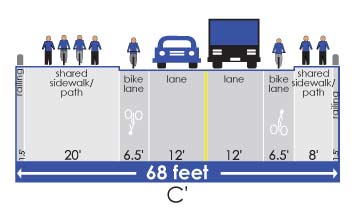
Scoring of roadway design options
To help guide decision-making on the project, members of the Citizen’s Task Force were asked assign a certain number of points (weight) to various criteria. These included: bike/ped access; residential impact; environment; auto/freight access; etc…
Within each criterion, represented interests chose a subset of priorities. Richard says the bike/ped representatives on the Task Force chose two priorities in weighing their criterion: safety and connectivity (how the paths enter and exit the bridge span).
The next steps
From this point in the process, the decision makers will choose four bridge options that will go into the Draft Environmental Impact Statement (DEIS). Richard says the choices will likely include one “perfect bridge”, the highest scoring bridge in the Citizen’s Task Force evaluation, a low residential impact option, and a bridge rehabilitation option.
Other bike/ped issues
Leaving the current bridge as bike/ped only
Richard says this option is being looked at (read my story and the discussion on it from a few weeks ago) but that everyone who has taken a closer look realizes it is unlikely to happen. Even if the current bridge was re-purposed, it would require costly upgrades, and the ongoing cost and performance of maintenance is also a risky unknown.
Richard says there are also concerns that as a bike/ped only bridge it would have trouble competing for federal funds with other, higher volume bridges.
Other concerns about about having a separate bike/ped only bridge include;
- Connectivity: how would people get from the old to the new bridge to catch a bus?
- If the old bridge falls down, we have to settle with whatever bike/ped facilities exist on the new bridge.
In the end, Richard says we’re, “better off working for world-class bike facilities on the new bridge.” I agree. We need to focus more on mixing modes effectively and safely, not looking for ways to separate each other (which is not possible in many situations anyways).
A detour bridge during construction
Construction of the bridge is likely to last at least two years. The question is, will a detour bridge have to be built? And, if so, will it accommodate all users? Richard told me that early conversations about a temporary bridge did not include bike facilities. Concerned at this, Richard now says, “it has been duly noted that a detour bridge without bike facilities is not acceptable.”
Access to the Riverview Cemetery
There is currently a delicate balance of public access and private property rights relating to bicycles in Riverview Cemetery. The owners have proven very cooperative in allowing bikes to ride through their property (even though problems have arisen in the past). Richard says there are many issues to consider about continued Cemetery access.
- If intersection design results in no more auto access at lower entrance (this is what ODOT prefers), than the owner might just close it to bikes as well.
- If the rate of bike trips through the cemetery skyrockets with a new and improved bridge (Richard thinks it won’t, because new users will primarily be recreational and would choose a riverfront loop over a challenging hill), will it force renewed discussion over how to manage public access?
Richard said they’ve kept cemetery bike access at the forefront “since day one in the process” but adds that his worst fear is that it ends up being worse (than now) in the end. Even though it’s private property, the route is currently listed on city bike maps and it provides a welcome shortcut for commuters and enthusiasts. However, it’s clear that when push comes to shove, the property owner is not going to go out of his way to accommodate bicyclists.
Richard Marantz is obviously very passionate about how bicycles fare in this long process and he’s doing a superb job representing our interests. We should all be grateful for his volunteer service.
Stay tuned for more coverage of the Sellwood Bridge Project as things progress. If you have questions about this project, leave them in the comments and Richard, myself, and other folks will try to answer them.
For more information, check out the very awesome Sellwood Bridge Project website.


